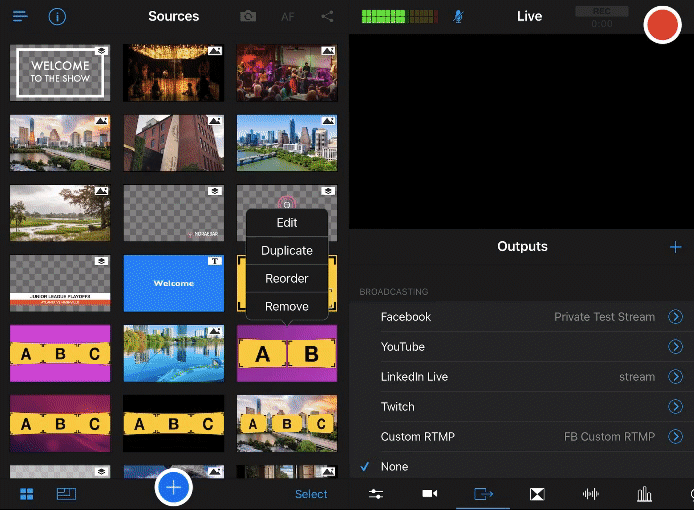Multiviews
A Multiview is an on-screen asset that allows you to combine multiple sources, such as camera angles and shared screens, into a single view. Multiviews can display up to nine sources and are available in a wide range of layouts, which can be customized to fit for your specific purposes.
In this article:
Compatible Multiview Sources
The following sources are able to be used as views using the Multiview feature.
-
Camera angles
-
Switcher Cast shared screens
-
Remote Guest shared screens
-
Remote Guest participants
-
Full-screen assets
-
Video assets (limited to 2)
Note: Currently, you can only use up to two pre-recorded Video Assets as part of all Multiview assets.
Creating a Multiview to Use in Your Production
-
Open the Switcher Studio app on the main switcher (iPad, iPhone).
-
Tap the plus icon (+).
-
Tap Multiviews.
-
Tap a template type based on the number of views or sources you want to use in the Multiview.
-
Tap your preferred template.
-
A Multiview Properties window will appear. You can customize the properties as outlined below.
-
-
Choose the Slot Assignment type.
-
Select Each Time: Each time you choose this Multiview, you will be prompted to select sources or assets to fill each slot.
-
Preselect: You will first select this Multiview's sources in the previous Multiview Properties window (camera and screen sources only). Then, every time you choose this Multiview, all slots will automatically be filled with your selections.
-
Reuse Current Source: You will first select all but one of this Multiview's sources in the previous Multiview Properties window. Then, every time you choose this Multiview, the final remaining slot will automatically be filled with your current (last-selected) source. Tap a new source to change the final slot, or re-tap the Multiview to remove it and display only your selected source.
-
-
If you chose Preselect or Reuse Current Source for the Slot Assignment, you will need to select the source for slots A, B, C, etc.
-
Select any of the desired Multiview customization options.
-
Tap done in the top-right corner.

Additional Multiview Customization Options
The customization options will vary depending on the template you select. Below is a list and description of all available customization options.
-
Number of Sources: The total number of camera angles / Assets you want to combine into the Multiview.
-
Transition Duration: The amount of time it takes to transition from an active source to a replacement source.
-
Background Color: The color behind the source windows.
-
Background Image: The photo or graphic behind the source windows. You can also find Gradients in the Background Image options.
-
Background Image Opacity: The level of transparency / opacity of the background image.
-
Spacing: The space between the source windows.
-
Uniform Gap: Makes the gaps between the windows and the frames uniform by cropping the tops and bottoms of the source windows.
-
Horizontal Gap: The gap between the source windows and the frame.
-
Reflection: The amount of reflection below the source windows.
-
Reflection Gap: The gap between the source windows and the reflection.
-
Perspective: The inward angle of the source windows.
-
Separator Direction: The angle of the separator that splits the frames.
-
Separator Position: The location of the separator relative to the edges of the frame.
-
Separator Thickness: The thickness of the separator line.
-
Separator Color: The color of the separator line.
-
Center: Centers the sources within the source windows.
-
Flap Angle: The inward angle of source A.
-
Flap Scale: The size of source A.
-
Inset Scale: The zoom level of source B.
-
Flap Margin: The space around source A.
-
Inset Margin: The horizontal space around source B.
-
Flap Format: The available ratio options for source A.
-
Border Color: The color of the separator lines.
-
Border Thickness: The thickness of the separator lines.
-
Rounding Radius: The corner radius of source B.
-
Horizontal Cropping: The horizontal cropping of source B.
-
Vertical Cropping: The vertical cropping of source B.
-
Position X: The horizontal position of source B.
-
Position Y: The vertical position of source B.
-
Scale: The size of source B.
-
Yaw: The horizontal tilt of source B.
-
Pitch: The vertical tilt of source B.
-
Roll: The rotation of source B.
Editing a Multiview Asset
To edit an existing Multiview asset:
-
Tap and hold the Multiview asset in the Sources panel.
-
Tap Edit.
-
Adjust the settings as desired.
-
Tap Done in the top right.

Using a Multiview During Your Production
-
Using the main switcher, tap the Multiview asset in the Sources panel.
-
For assets with a Select Each Time assignment type:
-
Tap the first source you would like to use.
-
Tap the second source you would like to use.
-
Continue this process for any additional sources.
-
Once all slots have been filled, the Multiview will display in the live feed.
-
-
For assets with a Preselect assignment type:
-
The Multiview asset will immediately display in the live feed using the preselected source.
-
-
For assets with a Reuse Current Source assignment type:
-
The Multiview asset will immediately display in the live feed with the last-selected source and any additional preselected sources.
-
-
Video Tutorial
Keyword(s): multiview, reuse, current, source, preselect, multiple, view
.png)